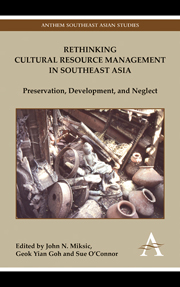Chapter 14 - The Preservation and Management of the Monuments of Champa in Central Vietnam: The Example of Mỹ Son Sanctuary, a World Cultural Heritage Site
from Vietnam
Published online by Cambridge University Press: 05 May 2012
Summary
MỹSon is the largest and most important of Champa's religious architectural sites in Central Vietnam; its Hindu temple-towers, which have stood over nine centuries from the fourth or fi fth through the thirteenth centuries CE, include approximately seventy structures. This chapter will address a range of issues including art history, preservation work and Mỹ Son's cultural landscape within the framework of cultural resource management.
Mỹ Son Historical Site
Mỹ Son Sanctuary is located in Mỹ Son village, Duy Phú Commune, Duy Xuyên District, Quång Nam Province, at N15°31' and E108°34'. The site, which lies approximately 70km southwest of the city of Danang, and some 50km west of Hoi An Ancient Town, was rediscovered in 1885 by a group of French colonial soldiers. Ten years later, Camille Paris cleared the site and between 1896 and 1899, Louis Finot and Etienne Lunet de Lajonquière came to Mỹ Son to do research on the Cham inscriptions found there. In 1901–2, Henri Parmentier studied Cham art and in 1903–4, along with Charles Carpeaux, he carried out archaeological excavations in Mỹ Son (Art Absolument 2005, 28–33). These activities culminated in 1904 with Finot and Parmentier's article published in the Bulletin de l'École Française d'Extrême-Orient (BEFEO) which describes their efforts to decipher Cham inscriptions and remnants of Cham art found in Mỹ Son (1904, 805–977).
Due to Mỹ Son's signifi cant historical and architectural value, it was listed as a World Cultural Heritage site by UNESCO in December 1999.
- Type
- Chapter
- Information
- Rethinking Cultural Resource Management in Southeast AsiaPreservation, Development, and Neglect, pp. 235 - 256Publisher: Anthem PressPrint publication year: 2011
- 1
- Cited by



